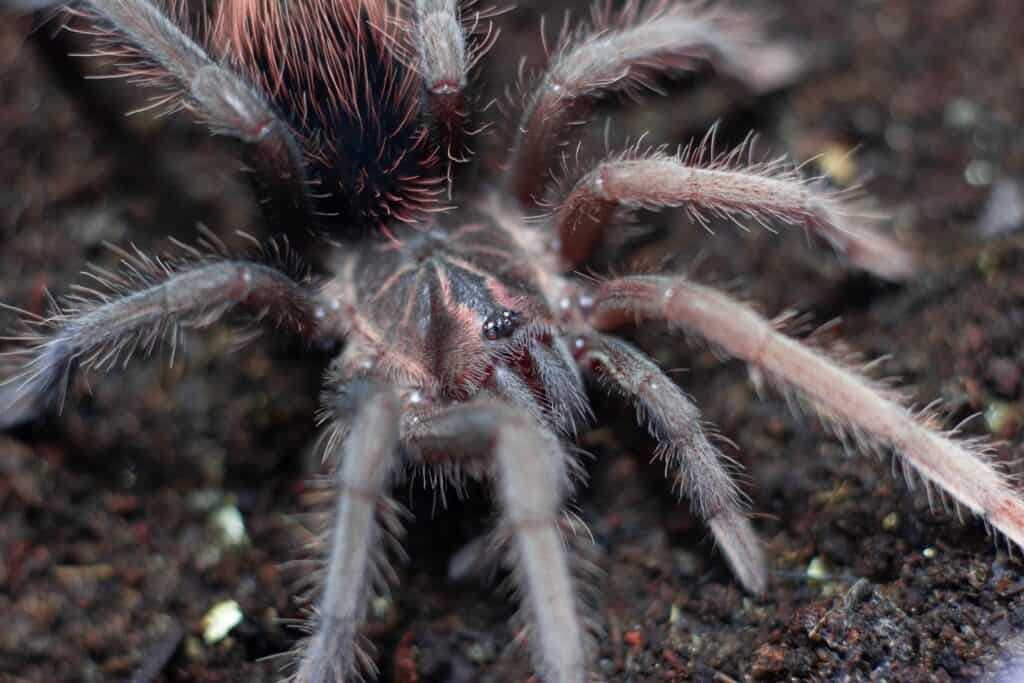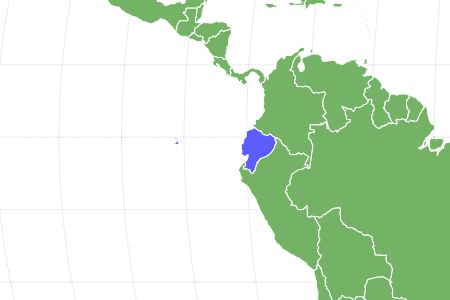Purple Tarantula
Avicularia purpurea
Females live more than twice as long as males, up to 12 years old.
Advertisement
Purple Tarantula Scientific Classification
- Kingdom
- Animalia
- Phylum
- Arthropoda
- Class
- Arachnida
- Order
- Araneae
- Family
- Theraphosidae
- Genus
- Avicularia
- Scientific Name
- Avicularia purpurea
Read our Complete Guide to Classification of Animals.
Purple Tarantula Conservation Status
Purple Tarantula Facts
- Prey
- insects, small lizards, small birds, crickets, roaches
- Main Prey
- insects
- Name Of Young
- spiderlings
- Group Behavior
- Solitary
- Fun Fact
- Females live more than twice as long as males, up to 12 years old.
- Most Distinctive Feature
- Their beautiful purple color.
- Other Name(s)
- purple tree tarantula, purple pinktoe tarantula, Ecuadorian purple tarantula
View all of the Purple Tarantula images!
A unique tarantula covered in purple bristles!
Purple tarantulas actually do have purple hairs that cover their bodies and legs. Their bristle-like hairs are called setae. They are a medium-sized docile tarantula from Ecuador. Because of their bright coloration they are sometimes kept as pets in the exotic pet trade. These tarantulas are arboreal, living in trees, making their nest in the crooks of tree branches and hollowed out trunks.
Amazing Purple Tarantula Facts
- They are can get to be 2 inches long with a leg span of 5 inches.
- Purple tarantulas are native to Ecuador in South America.
- They are docile and make good pets.
- Instead of living in burrows in the ground they live in trees.
- They can flick their urticating hairs at a predator in self-defense.
Purple Tarantula Scientific Name
The scientific name of the purple tarantula is Avicularia purpurea. They are also called purple pinktoed tarantulas, Ecuadorian purple tarantula, Ecuador purple pinktoe, purple tree tarantulas. Their common name is obviously from their purple color, but their scientific name comes from an early artist’s description of the purple tarantula. Linnaeus named the species back in 1758, as described by artist and entomologist Maria Sibylla Merian. The Latin word avicula means “small bird” which refers to a painting by Merian which shows a purple tarantula eating a hummingbird. While tarantulas can eat birds it is more likely that they eat insects, but the name has stuck with this species.
Purple Tarantula Appearance

Purple tarantulas actually do have purple hairs that cover their bodies and legs. Their bristle-like hairs are called setae.
©Alexpress/Shutterstock.com
Tarantulas come in a rainbow of colors with the purple tarantula not disappointing. Their iridescent purple hue is remarkable. The abdomens are all black with a purple head (carapace) and purple hair covered legs. Their hairs, or bristles, give off an irredescent shimmer that makes them stand out.
The females are larger than the males and more stocky with the largest getting to be 2 inches long with a leg span of 5 inches. Their bodies have two segments with an abdomen and a head (or carapace). On top of the head are eight eyes with two being larger than the others. They have eight jointed legs and two appendages that are at the front of their bodies that look like arms. These appendages are called pedipalps and they are used for grabbing and holding prey. Males use their specially adapted pedipalps during mating. At the back of the tarantulas are spinnerets.
Purple Tarantula Behavior
Purple tarantulas are pretty docile although they can move fast. They are arboreal, living in trees and making their webbed nests in the branches or hollows. Their spider web provides protection from approaching predators as well as a way to catch prey to eat. They ball up their prey with their web and then inject it with their digestive juices, making their prey into a liquid that they can suck up for nutireints.
In captivity these spiders are easy to care for and interesting to watch. They will remain out in the open so you can see them and they make extensive webs in the branches of their enclosure.
Purple tarantulas need to molt their exoskeleton so they can make room for their growing bodies. They make molt multiple times a year when they are young and then they usually molt once a year, leaving their old exoskeleton behind. Before a molt it is common for a tarantula to stop eating for a few weeks.
Purple Tarantula Habitat
The habitat of the Purple tarantulas is arboreal, with the tarantulas spinning webs in the crooks of tree branches and in hollowed out trunks. They are excellent climbers and can scale a tree trunk quite quickly.
The purple tarantula is native to Ecuador, living in the Amazon rainforests where the climate is hot and humid. In captivity these spiders prefer a hot and humid environment as well. A large enclosure with a variety of plants and vegetation is the perfect set up.
They are solitary animals living just one spider to a nest. The only time they come together is when it is time to mate.
Purple Tarantula Predators and Threats
The purple tarantula has several predators including other arboreal snakes, lizards, birds and larger spiders. The purple tarantula can take shelter I their webbed nests or flee if approached. They can also flick their urticating hairs at a predator which cause irritation. If they hairs get in the predators eyes they can cause blindness.
What Eats Purple Tarantulas?
Some of the animals that live in the rainforests of Ecuador that eat Tarantulas include snakes, lizards, birds and larger spiders. Tarantula hawks, a large wasp, also prey on tarantulas by paralyzing them and burying them alive. Before burying them they inject one single egg into their abdomen and when the egg hatches it feeds on the tarantula. Tarantula hawks are common throughout South America.
What Do Purple Tarantulas Eat?
Purple tarantula’s main diet includes insects. Whatever might fly into their webs they will wrap in more web, and liquefy their insides before sucking up the nutrients.
As pets you can feed your purple crickets, mealworms and roaches. They prefer a few large meals every few days vs daily feeding. Before a molt they can go for weeks without eating at all.
What is the Conservation Status of Purple Tarantulas?
Purple tarantulas are not listed by the IUCN as a threatened animal. They seem to be readily available in the pet trade inferring that they have a healthy population.
Reproduction, Babies, and Lifespan
When males reach the age of maturity, usually around 3-4 years, they will leave their nests and search for a female. Females are relatively choosing and may try to attack a male when they confront her. If the female is receptive they will allow the male to mate with them and then retreat to her nest. Males may only live a few months after mating with an average life span of 3-4 years.
The females produce around 100-120 eggs which she wraps up in a ball of silky web. She will guard them until they are ready to hatch. After about 6-8 weeks the spiderlings will hatch and eventually take off on their own to create their own nests.
The life span of the female purple tarantula is much longer than the males with some living as long as 10-12 years. Pet enthusiasts generally try to get a female so that they can enjoy their pet for a longer time.
Population
It is difficult to get an accurate count of tarantulas living in trees in the dense rainforest of Ecuador. The IUCN who monitors species that are at risk of being threatened do not have this species listed. They are also readily available in the pet trade so it seems they have a healthy population.
Related Animals
View all 192 animals that start with PPurple Tarantula FAQs (Frequently Asked Questions)
Are purple tarantulas venomous?
Yes, they are venomous but their venom is mild and not harmful to humans. They are also not aggressive and rarely bite.
How big do purple tarantulas get?
The females are around 2 inches long with a leg span of 5 inches. The males are a bit smaller.
Do purple tarantulas make webs?
Yes, they make webs I the crooks of trees and hollows as nests to protect them from predators.
Where are purple tarantulas from?
They are native to Ecuador in South America.
Are purple pinktoed tarantulas docile?
Yes, they are a docile spider that are pretty easy going.
Are purple tarantulas good pets?
Yes, they make good pets if you want a “display pet”. They are interesting to watch and make interesting webs in their enclosures.
Can you pick up a purple tarantula?
It is better not to pick up a purple tarantula. They are docile and rarely bite but can become skittish.
Thank you for reading! Have some feedback for us? Contact the AZ Animals editorial team.
Sources
- UCL Culture Blog, Available here: https://blogs.ucl.ac.uk/museums/2018/09/28/specimen-of-the-week-360-the-pinktoe-tarantula/
- Everything Reptiles / Johnathan David, Available here: https://www.everythingreptiles.com/avicularia-purpurea/
- Spider Identifications, Available here: https://spideridentifications.com/purple-tarantula.html

















